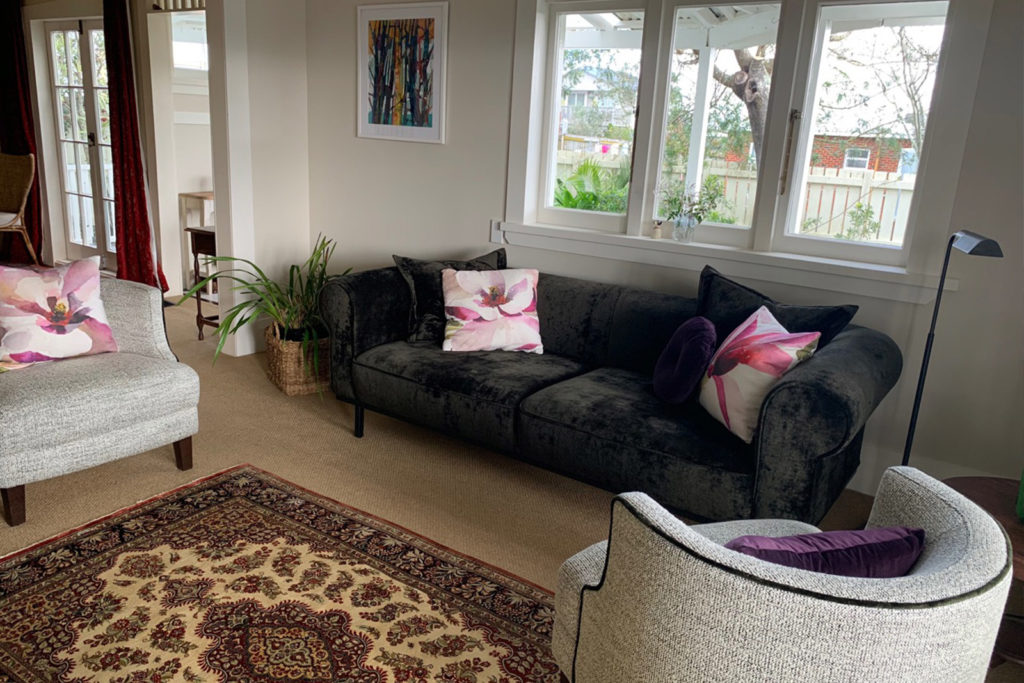Debbie Abercrombie
With an illustrious design career Debbie Abercrombie draws from both educational knowledge and insightful experience to deliver truly exceptional interior spaces to happy clients throughout the Auckland region.
Always busy and excited for the next brief, she’s putting her know-how to good use both re-shaping rooms and, with regular classes, educating the masses on colour, style, fashion and functionality. We asked Debbie about what inspired and challenged her approach…
What first made you decide to move into interior design?
During my time running my own label and business as a clothing designer we were always renovating, renovating, renovating. Then it got serious with a new architectural build and I had to upskill to meet the sophistication of this project. So I enrolled to study interior design and, from that decision 30 years ago, I’ve never looked back!
What inspires you in your design?
Quite simply it’s the project and the people. I’m inspired by my client’s environment and the adventure they’re prepared to take with it. It’s such a rewarding job when these clients allow an outside perspective to make their space refreshed, improved and exceptional. Being able to deliver these exciting changes is an inspiration in itself.
Designers are also exposed to a great variety of new products – and new ways to use existing products. Working in such a stimulating environment with committed suppliers is hugely beneficial too.
How do you approach a new project?
I have to arrive at each new project with an open book. First I get to know the clients and their expectations for the space. Then we set a brief and the boundaries that work for them and establish exactly how value will be added.

What have you been working on recently?
There’s been a lot spent recently on ‘the 3 R’s’: redecorating, renovating and rebuilding. I suspect most of us have spent more time at home this year than expected and, in doing so, realised this set-up may become the new way of doing things. So it makes sense to make our homes the best they can be and enjoy every little bit!
What are some of your more memorable projects?
Sometimes work can be judged on the response from the client. For example, one project involved delivering a facelift to a significant home on the market. After everything was completed the client told me that, had they known how stunning their existing home could be, they would never have done a new build and just stayed where they were!
My most memorable projects are the ones where I meet with a client and identify a few critical flaws in the proposal, whether it is in the layout or product choices. I am then able to steer them in a positive direction to a far superior final result.
What do you like about working in Auckland?
It’s simple: the variety. There is so much range to the built environments around the city that you’re always discovering new spaces – and ways to improve and enhance them.
Why is interior design important?
There is nothing better than spaces that work functionally and aesthetically. It is the ability to combine both that is so vital. In doing so you need to have a very strong understanding of how the client lives and what appeals to them. After all, they live in the space so they should love it!
You run a series of courses on colour – what makes this work interesting?
Colour can be very subjective. What I love about teaching is giving others the ability to understand colour and to give them objective reasons why something works (or doesn’t work). If you understand colour you can push boundaries and do something unexpected that adds value while also working within the overall scheme. It’s like switching on a light when someone can discover new ways of looking at and understanding colour.
What design trends are worth re-evaluating?
That’s a broad question and, honestly, they all are. It comes down to the bones of the space you are working with and then drawing material and ideas from past sources that are applicable and appropriate to this space. We all use history to enhance our knowledge. It’s how we apply and adapt this history to today’s work that makes such a difference.
How do you think the big changes of 2020 will affect interior design?
It will only make people appreciate good interiors more. We may travel less, whether this is to work on an everyday basis or overseas. And we’ll probably be spending more time at home. So this space must be ideally enjoyable and functional. As we re-evaluate what is important and I feel certain more of us will start to appreciate the value of having a warm, inviting and interesting home.

Do you have a favourite Kovacs piece?
It would have to be the Henley. It’s modern but traditional, elegant but simple, stylish but comfortable. Strong in its line, but soft in its curve, this design will never date.
What are three things you can’t live without?
Family, good friends and hugs.
